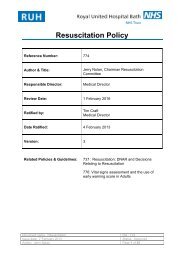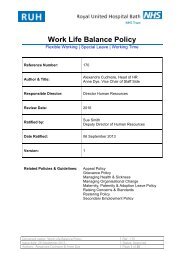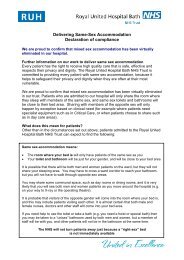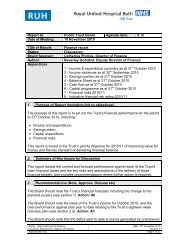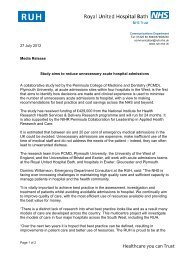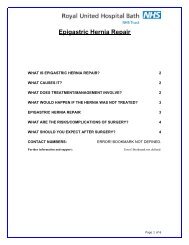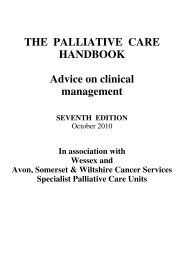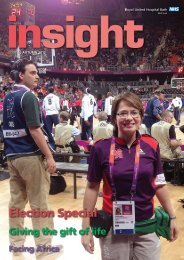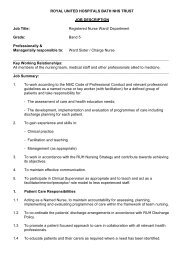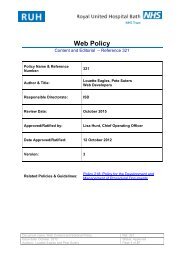(NPWT) including Vacuum Assisted Closure (Vac) - Royal United ...
(NPWT) including Vacuum Assisted Closure (Vac) - Royal United ...
(NPWT) including Vacuum Assisted Closure (Vac) - Royal United ...
Create successful ePaper yourself
Turn your PDF publications into a flip-book with our unique Google optimized e-Paper software.
20. References<br />
• Alvarez, A.A. et al. (2001). Case report vacuum-assisted closure for cutaneous<br />
gastrointestinal fistula management. Gynaecologic Oncology, 80, pp. 413-16.<br />
• Armstrong, D.G. et al. (2002). Outcomes of sub-atmospheric pressure dressing<br />
therapy on wounds of the diabetic foot. Ostomy Wound Management, 48(4),<br />
pp.64-68.<br />
• Azad, S. & Nishikawa H. (2002). Topical negative pressure may help chronic<br />
wound healing. BMJ, 324, pp.1100.<br />
• Baynham, S. A. et al. (1999). Treating stage IV pressure ulcers with negative<br />
pressure therapy: A case report. Ostomy/Wound Management 45 (4), pp. 28-35.<br />
• Caro, A. et al. 2011. Treatment of the open abdomen with topical negative<br />
pressure therapy: a retrospective study of 46 cases. International Wound<br />
Journal 8 (3), pp. 274-9.<br />
• Department of Health, 2005. Mental Capacity Act. London: Department of<br />
Health.<br />
• FDA (2011). FDA safety communication: Update on serious complications<br />
associated with negative pressure wound therapy systems [Online]. Available<br />
at: http://www.fda.gov/MedicalDevices/Safety/AlertsandNotices/ucm244211.htm<br />
[Accessed 16 Nov. 2012]<br />
• FDA (2009). Preliminary public health notification: Serious complications<br />
associated with negative pressure wound therapy systems [Online]. Available at:<br />
http://www.fda.gov/MedicalDevices/Safety/AlertsandNotices/PublicHealthNotificat<br />
ions/ucm190658.htm[Accessed 16 Nov 2012].<br />
• Fraccalvieri, M. et al. 2011. Patients pain feedback using negative pressure<br />
wound therapy with foam and gauze. International Wound Journal 8 (5), pp. 492-<br />
9.<br />
• Garner, G. B. (2001). <strong><strong>Vac</strong>uum</strong>-assisted wound closure provides early fascial reapproximation<br />
in trauma patients with open abdomens. The American Journal of<br />
Surgery, 182 pp.630-638<br />
• Heugel, J.R. et al. (2002). Treatment of the exposed Achilles tendon using<br />
negative pressure wound therapy: a case report. Journal of Burn Care &<br />
Rehabilitation, 23 (3), pp. 167-71.<br />
• Joseph, E. et al. (2000). A prospective, randomised trial of vacuum-assisted<br />
closure versus standard therapy of chronic non-healing wounds. Wounds, 12(2):<br />
60-7.<br />
• KCI (2009). Clinical Guidelines for the Management of the Open Abdomen with<br />
KCI Systems for Active Abdominal Therapy. London: MEP.<br />
• KCI (2007). V.A.C. ® Therapy Clinical guidelines. London: MEP.<br />
• Krasner, D.L. (2002). Managing wound pain in patients with vacuum-assisted<br />
closure devices. Ostomy Wound Management, 48 (5) pp.38-43.<br />
Document name: Negative Pressure Wound Therapy (<strong>NPWT</strong>) Ref.: 745<br />
Issue date: 10 June 2013<br />
Status: Approved<br />
Author: Kate Purser and Nicola Heywood Page 16 of 20



